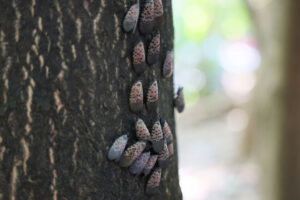Spotted Lanternfly Hatch Is Here, New Jersey. What You Can Do!
Spring is here. Spotted Lanternfly hatch is beginning this month. What can homeowners do?
New research shows that the Spotted Lanternfly is not as deadly to our trees and forests as first thought. For homeowners SLF are more of a nuisance pest with their numbers, the sticky honeydew they release as they feed, and the black sooty mold that grows on that honeydew.

(Photo by Michael M. Santiago/Getty Images)
Watch for the Nymph!
One thing homeowners can do from the start is be on the lookout for the tiny black nymph with white spots. The nymphs will be walking around in search of young roses, perennials, and grapes. When you see egg masses on trees, or know the trees where being fed on by SLF last year, you can place circle traps or sticky bands in the area, that you can purchase at the big box hardware stores. Meanwhile, the good old foot smoosh is still the most common way to take care of these young pests.
Insecticides. What to use and when.
If your young plants are overwhelmed with nymphs, as a last resort you can use some contact insecticide products containing insecticidal soap, natural pyrethrins, or neem oil. Always refer to the label for use of insecticides. Remember, the label is the law. Do not spray plants during their bloom period to minimize sprays contacting friendly insects such as bees and other pollinators. According to Rutgers University’s NJ Agricultural Department, homemade remedies are not recommended.

(Photo by Michael M. Santiago/Getty Images)
Nature’s help is on the way!
while we may not be rid of the SLF invasion soon, some local friends are catching on to help us control these invaders. Some of the SLF’s top predators include local chickens, cardinals, catbirds, blue jays, praying mantis, yellow jackets, orb-weaver spiders, and even ants! It seems nobody likes a Lanternfly!

(Photo by Drew Hallowell/Getty Images)
For more information on the Spotted Lanternfly hatch, you can visit http://www.nj.gov/agriculture/divisions/pi/prog/pests-diseases/spotted-lanternfly/homeowner-resources


